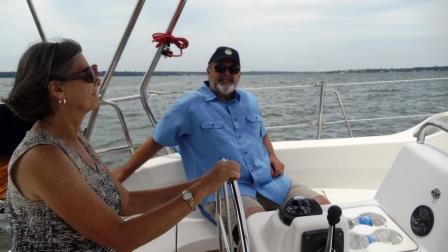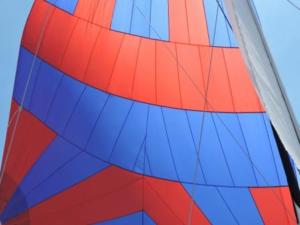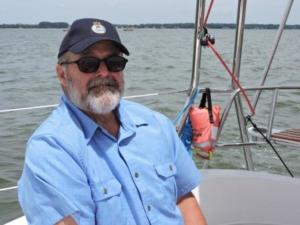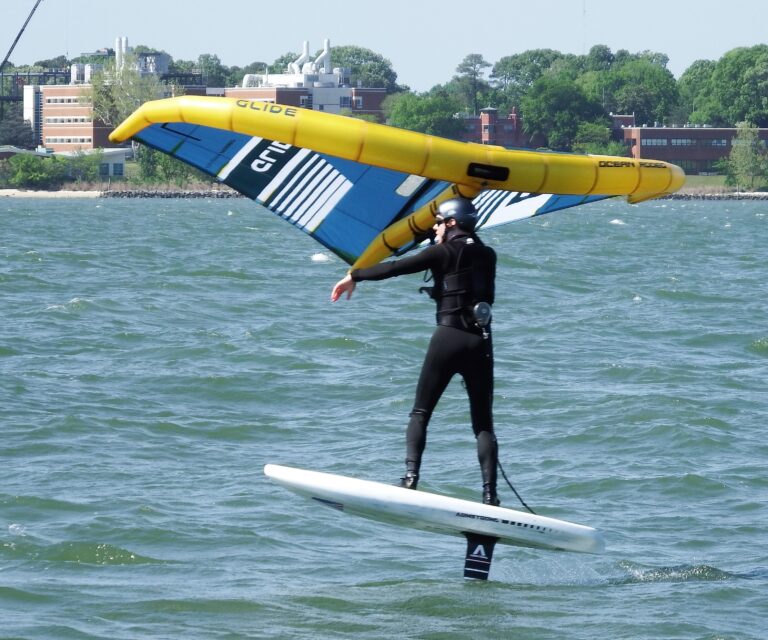
Question: How do you go sailing downwind?
Answer: Raise the spinnaker.
 Sometimes you need a break from the grandchildren. Jennie and Jeff Seiler care permanently for their three grandsons, who were off visiting their mother for the summer. The Seilers took a leisurely cruise on the York River as light winds prevailed in the morning. We put up the spinnaker to take advantage of the downwind breeze.
Sometimes you need a break from the grandchildren. Jennie and Jeff Seiler care permanently for their three grandsons, who were off visiting their mother for the summer. The Seilers took a leisurely cruise on the York River as light winds prevailed in the morning. We put up the spinnaker to take advantage of the downwind breeze.
Jeff and I went forward to pull up the chute from the bow hatch as Jennie guided the boat carefully off the wind. Before long we were up and away, quietly moving at 4 mph in a diagonal from Gloucester Beach to Wormley Creek across the river.
 I could tell Jennie had an earlier life that required focus, determination and attention to detail. “Were you a teacher?” I asked. “Yes, second grade.”
I could tell Jennie had an earlier life that required focus, determination and attention to detail. “Were you a teacher?” I asked. “Yes, second grade.”
Jeff is a retired Navy chaplain. “I worked mostly with Marines. I was the command chaplain on the Enterprise, with a crew of 5,500 when the air wing was aboard. Today the ship is mostly parts, decommissioned for scrap.” The USS Enterprise was an early nuclear aircraft carrier that was notable for having too much redundancy of nuclear reactors. “It had eight reactors, whereas today they operate with just two.”
Vietnam duty
Well before he was a chaplain, “I was a Marine grunt in Vietnam, doing recon throughout I Corps in 1970-72. I was there when Le Duc Tho signed the peace treaty with Henry Kissinger. I was home by the time the POWs were released. That was quite a sight. Because I came back at the same time, some people wondered if I was POW. Other people gave me a hard time. This was in Massachusetts, which was very anti-war. My Episcopal minister gave a homily where he praised the men who went to Canada as heroes and called those of us who went to Vietnam cowards. I left the church for three years after that.”

We saw dolphins diving, and they disappeared as the winds and waves began to build. Jeff and I had to get the spinnaker down before the winds would drive the bow down into the water.
Jeff recalled, “In the Navy we crossed the Atlantic once during a storm. The bow kept going down into the ocean and water would crash over the bow and into the bridge. We watched as the ship’s big brass bell flew across the deck and out to sea. It was as big as this,” he pointed to the pedestal, which is 3x2x2 feet. “We were listing 38 degrees.” By contrast, at this moment we were listing 10 degrees.
 “During crossings in the Atlantic, as well as the Pacific, we would pass sailors in boats no bigger than yours. We’d wave to them and they’d wave to us, apparently okay. It was crazy of them.”
“During crossings in the Atlantic, as well as the Pacific, we would pass sailors in boats no bigger than yours. We’d wave to them and they’d wave to us, apparently okay. It was crazy of them.”
As our speed began to build, it reminded Jeff of an earlier event. “I was on the nuclear destroyer Mississippi in a carrier group when we got word to redeploy to Serbia, like yesterday. The carrier Roosevelt took off ahead of us. Our own rooster tail wake was higher than the bridge as we approached 40 mph. Our boat was rattling and shaking from the speed vibration. The Roosevelt slid past and left us easily at a considerably higher speed. They say carriers can go 40-plus, but they don’t tell you how much ‘plus’ is.
“Much later, on the ground in Serbia, after the war was resolved by the Dayton Accords, a man came up and hugged me. ‘You save my life,’ he exclaimed. Of course, the other [Croatian] guys could say the same.”
Still, that was an improvement over his Vietnam homecoming.
Let’s Go Sail
Check rates and pick a day for a sailboat charter. See reviews on Trip Advisor from sailors like you.



